Trend in H2S Biology and Medicine Research—A Bibliometric Analysis
Abstract
:1. Introduction
2. Methods
2.1. Search Tools
2.2. Search Strategies
3. Results
3.1. Evolution of H2SBM Research
3.2. The Top 10 Mostly Cited Publications in H2SBM Research
3.3. The Most Receptive H2SBM Research Publication Avenues
3.4. The Most Prolific Countries with H2SBM Research Publications
3.5. The Most Prolific Institutions with H2SBM Research Publications
3.6. The Support of H2SBM Research by Different Funding Agencies
3.7. Researcher Citation Impact
3.8. Other Publication Performance Indicators
4. Discussion
Acknowledgments
Author Contributions
Conflicts of Interest
References
- Zhao, W.; Zhang, J.; Lu, Y.; Wang, R. The vasorelaxant effect of H2S as a novel endogenous gaseous KATP channel opener. EMBO J. 2001, 20, 6008–6016. [Google Scholar] [CrossRef] [PubMed]
- Wang, R. Two’s company, three’s a crowd: Can H2S be the third endogenous gaseous transmitter? FASEB J. 2002, 16, 1792–1798. [Google Scholar] [CrossRef] [PubMed]
- Abe, K.; Kimura, H. The possible role of hydrogen sulfide as an endogenous neuromodulator. J. Neurosci. 1996, 16, 1066–1071. [Google Scholar] [PubMed]
- Yang, G.; Wu, L.; Jiang, B.; Yang, W.; Qi, J.; Cao, K.; Meng, Q.; Mustafa, A.K.; Mu, W.; Zhang, S.; et al. H2S as a physiologic vasorelaxant: Hypertension in mice with deletion of cystathionine gamma-lyase. Science 2008, 322, 587–590. [Google Scholar] [CrossRef] [PubMed]
- Hosoki, R.; Matsuki, N.; Kimura, H. The possible role of hydrogen sulfide as an endogenous smooth muscle relaxant in synergy with nitric oxide. Biochem. Biophys. Res. Commun. 1997, 237, 527–531. [Google Scholar] [CrossRef] [PubMed]
- Szabó, C. Hydrogen sulphide and its therapeutic potential. Nat. Rev. Drug Discov. 2007, 6, 917–935. [Google Scholar] [CrossRef] [PubMed]
- Elrod, J.W.; Calvert, J.W.; Morrison, J.; Doeller, J.E.; Kraus, D.W.; Tao, L.; Jiao, X.; Scalia, R.; Kiss, L.; Szabo, C.; et al. Hydrogen sulfide attenuates myocardial ischemia-reperfusion injury by preservation of mitochondrial function. Proc. Natl. Acad. Sci. USA 2007, 104, 15560–15565. [Google Scholar] [CrossRef] [PubMed]
- Wang, R. Physiological implications of hydrogen sulfide: A whiff exploration that blossomed. Physiol. Rev. 2012, 92, 791–896. [Google Scholar] [CrossRef] [PubMed]
- Li, L.; Rose, P.; Moore, P.K. Hydrogen sulfide and cell signaling. Annu. Rev. Pharmacol. Toxicol. 2011, 51, 169–187. [Google Scholar] [CrossRef] [PubMed]
- Kimura, Y.; Kimura, H. Hydrogen sulfide protects neurons from oxidative stress. FASEB J. 2004, 18, 1165–1167. [Google Scholar] [CrossRef] [PubMed]
- Wang, R. Gasotransmitters: Growing pains and joys. Trends Biochem. Sci. 2014, 39, 227–232. [Google Scholar] [CrossRef] [PubMed]
- Wang, R. Hydrogen sulfide: The third gasotransmitter in biology and medicine. Antioxid. Redox Signal. 2010, 12, 1061–1064. [Google Scholar] [CrossRef] [PubMed]
- Kimura, H. H2S2014 in Kyoto: The 3rd international conference on H2S in biology and medicine. Nitric Oxide 2015, 46, 1–6. [Google Scholar] [CrossRef] [PubMed]
- Calvert, J.W. The summer of hydrogen sulfide: Highlights from two international conferences. Med. Gas Res. 2013, 3, 5. [Google Scholar] [CrossRef] [PubMed]
- Robert, C.; Wilson, C.S.; Venuta, A.; Ferrari, M.; Arreto, C.D. Evolution of the scientific literature on drug delivery: A 1974–2015 bibliometric study. J. Control. Release 2017, 260, 226–233. [Google Scholar] [CrossRef] [PubMed]
- Garner, R.M.; Hirsch, J.A.; Albuquerque, F.C.; Fargen, K.M. Bibliometric indices: Defining academic productivity and citation rates of researchers, departments and journals. J. Neurointerv. Surg. 2017. [Google Scholar] [CrossRef] [PubMed]
- Falagas, M.E.; Pitsouni, E.I.; Malietzis, G.A.; Pappas, G. Comparison of PubMed, Scopus, Web of Science, and Google Scholar: Strengths and weaknesses. FASEB J. 2008, 22, 338–342. [Google Scholar] [CrossRef] [PubMed]
- Tetsworth, K.; Fraser, D.; Glatt, V.; Hohmann, E. Use of Google Scholar public profiles in orthopedics. J. Orthop. Surg. (Hong Kong) 2017, 25. [Google Scholar] [CrossRef] [PubMed]
- Chua, S.K.; Qureshi, A.M.; Krishnan, V.; Pai, D.R.; Kamal, L.B.; Gunasegaran, S.; Afzal, M.Z.; Ambawatta, L.; Gan, J.Y.; Kew, P.Y.; et al. The impact factor of an open access journal does not contribute to an article’s citations. F1000Research 2017, 6, 208. [Google Scholar] [CrossRef] [PubMed]
- Mustafa, A.K.; Gadalla, M.M.; Sen, N.; Kim, S.; Mu, W.; Gazi, S.K.; Barrow, R.K.; Yang, G.; Wang, R.; Snyder, S.H. H2S signals through protein S-sulfhydration. Sci. Signal. 2009, 2, ra72. [Google Scholar] [CrossRef] [PubMed]
- Baldock, C.; Ma, R.; Orton, C.G. Point/counterpoint. The h-index is the best measure of a scientist’s research productivity. Med. Phys. 2009, 36, 1043–1045. [Google Scholar] [CrossRef] [PubMed]
- Callaham, M.; Wears, R.L.; Weber, E. Journal prestige, publication bias, and other characteristics associated with citation of published studies in peer-reviewed journals. JAMA 2002, 287, 2847–2850. [Google Scholar] [CrossRef] [PubMed]
- Tahamtan, I.; Safipour, A.; Ahamdzadeh, K. Factors affecting number of citations: a comprehensive review of the literature. Scientometrics 2016, 107, 1195–1225. [Google Scholar] [CrossRef]
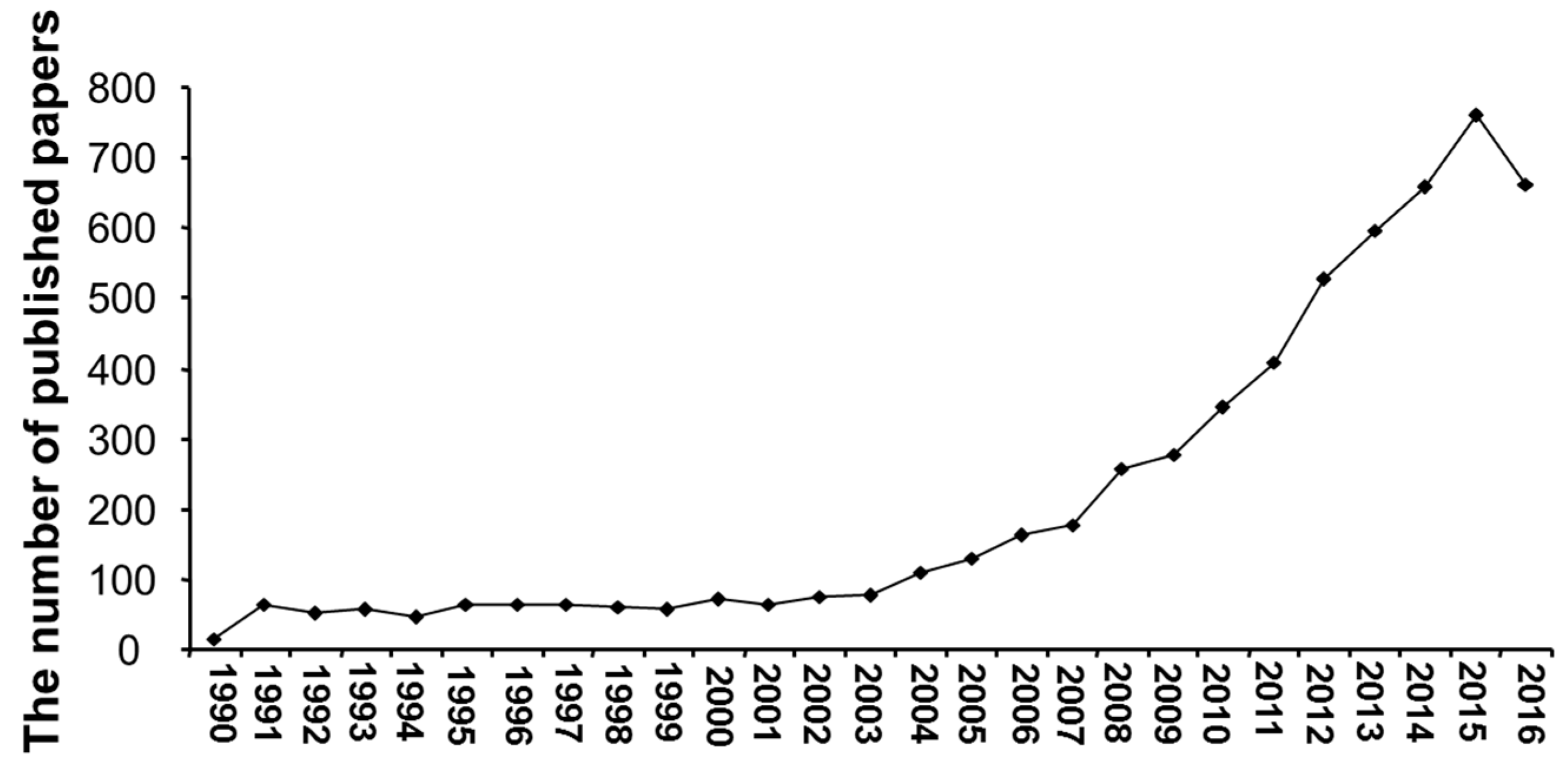
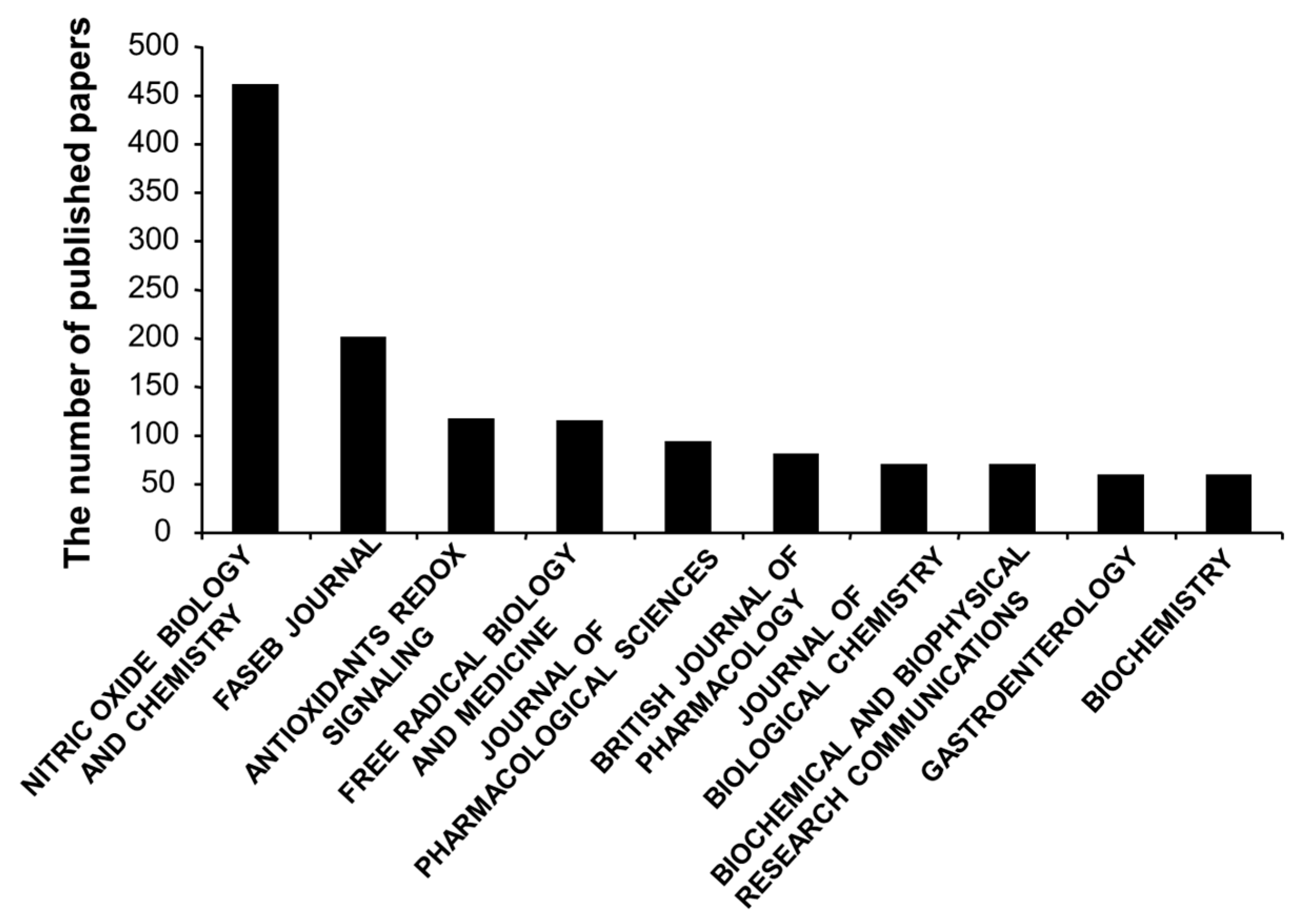
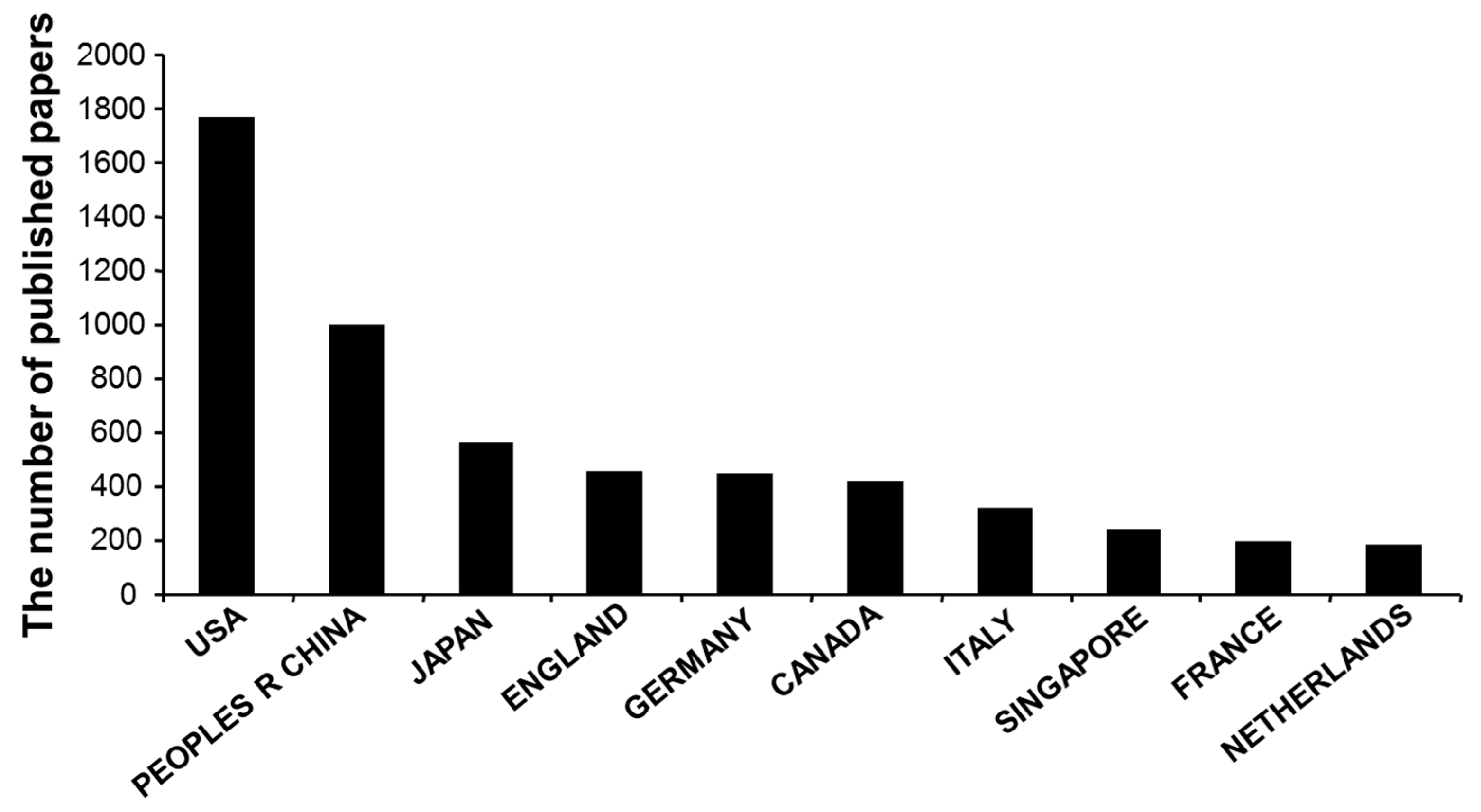
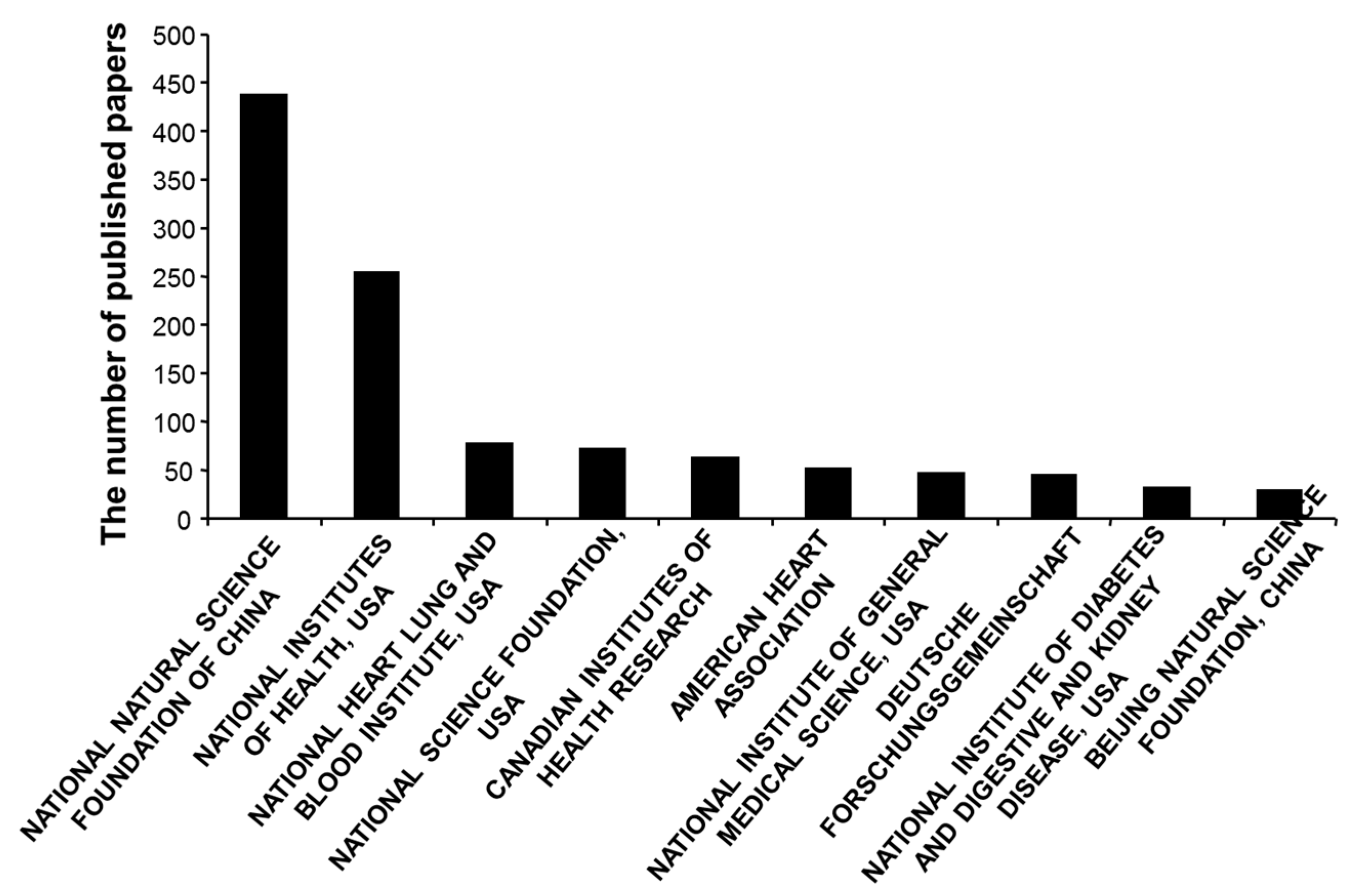
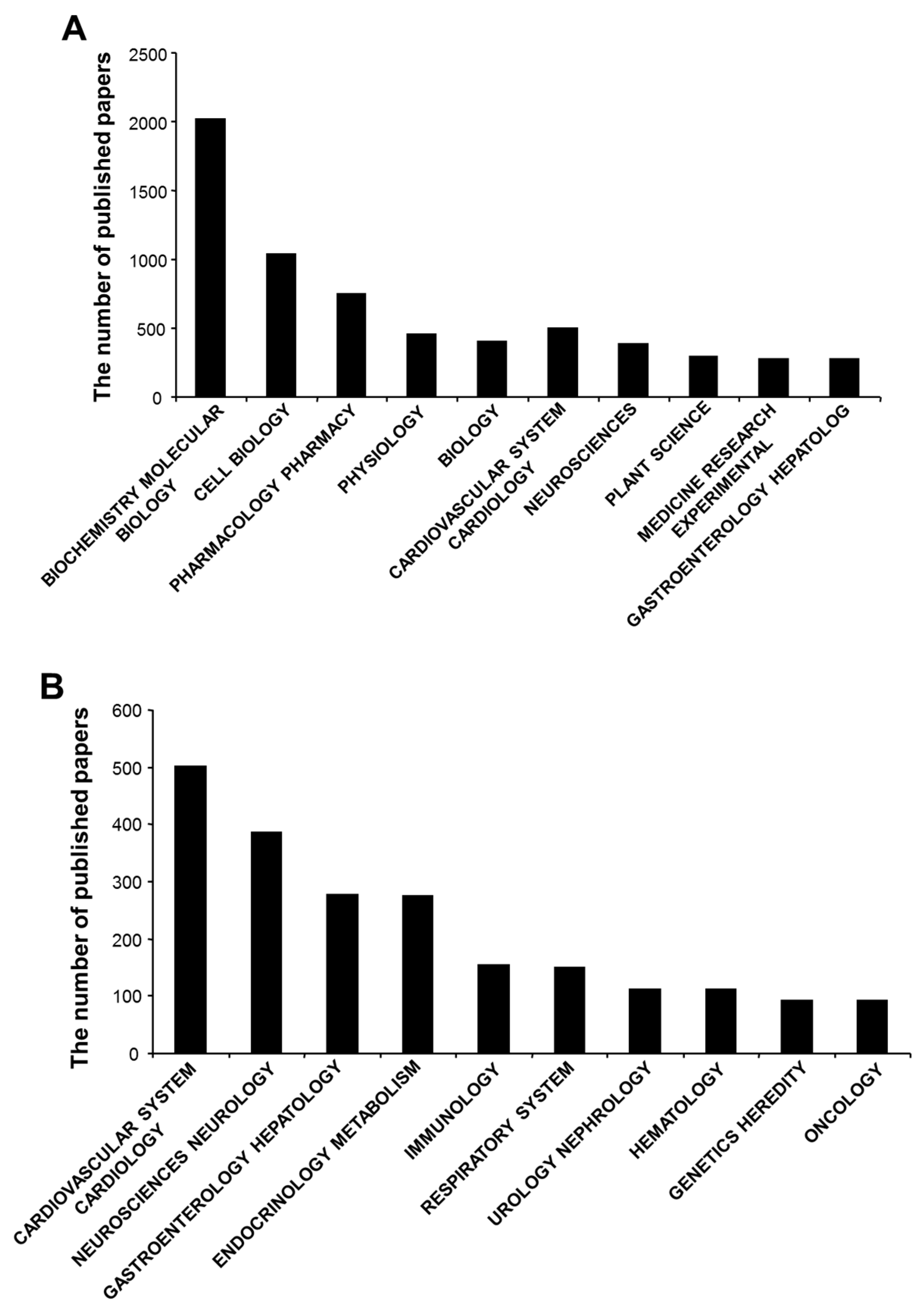
| Rank | Title | Author (First and/or Last Author) | Journal | Journal Impact Factor (2016) | Publishing Information | Citation (A) | Citation (B) | Citation (C) |
|---|---|---|---|---|---|---|---|---|
| 1 | The vasorelaxant effect of H2S as a novel endogenous gaseous KATP channel opener | Zhao W., Zhang J., Lu Y., Wang R. * | EMBO JOURNAL | 9.792 | 1 November 2001;20(21):6008–6016. | 1414 | 1073 | 1754 |
| 2 | Two’s company, three’s a crowd: can H2S be the third endogenous gaseous transmitter? | Wang R. * | FASEB JOURNAL | 5.498 | November 2002;16(13):1792–1798. | 1348 | 1025 | 1671 |
| 3 | The possible role of hydrogen sulfide as an endogenous neuromodulator | Abe K., Kimura H. * | JOURNAL OF NEUROSCIENCE | 5.988 | 1 February 1996;16(3):1066–1071. | 1276 | 1016 | 1536 |
| 4 | H2S as a physiologic vasorelaxant: hypertension in mice with deletion of cystathionine γ-lyase | Yang G., Wu L. *, Jiang B., Yang W., Qi J., Cao K., Meng Q., Mustafa A.K., Mu W., Zhang S., Snyder S.H. *, Wang R. * | SCIENCE | 37.205 | 24 October 2008;322(5901):587–590. | 1254 | 1061 | 1447 |
| 5 | Hydrogen sulphide and its therapeutic potential | Szabó C. * | NATURE REVIEWS DRUG DISCOVERY | 57.0 | November 2007;6(11):917–935. | 1038 | 866 | 1210 |
| 6 | The possible role of hydrogen sulfide as an endogenous smooth muscle relaxant in synergy with nitric oxide | Hosoki R., Matsuki N., Kimura H. * | BIOCHEMICAL AND BIOPHYSICAL RESEARCH COMMUNICATIONS | 2.466 | 28 August 1997;237(3):527–531. | 901 | 693 | 1109 |
| 7 | Hydrogen sulfide attenuates myocardial ischemia-reperfusion injury by preservation of mitochondrial function | Elrod J.W., Calvert J.W., Morrison J., Doeller J.E., Kraus D.W., Tao L., Jiao X., Scalia R., Kiss L., Szabo C., Kimura H., Chow C.W., Lefer D.J. * | PROCEEDINGS OF THE NATIONAL ACADEMY OF SCIENCES OF THE UNITED STATES OF AMERICA | 9.661 | 25 September 2007;104(39):15560–15565. | 675 | 559 | 791 |
| 8 | Physiological implications of hydrogen sulfide: a whiff exploration that blossomed | Wang R. * | PHYSIOLOGICAL REVIEWS | 27.312 | April 2012;92(2):791–896. | 634 | 537 | 731 |
| 9 | Hydrogen sulfide and cell signaling | Li L., Rose P., Moore P.K. * | ANNUAL REVIEW OF PHARMACOLOGY AND TOXICOLOGY | 12.877 | 2011;51:169–187. | 616 | 535 | 697 |
| 10 | Hydrogen sulfide protects neurons from oxidative stress | Kimura Y., Kimura H. * | FASEB JOURNAL | 5.498 | July 2004;18(10):1165–1167. | 597 | 456 | 738 |
| Rank | Institute | Total Publication | Total Citations | Average Citations per Item | h-Index |
|---|---|---|---|---|---|
| 1 | National University of Singapore | 235 | 9424 | 40.1 | 55 |
| 2 | Peking University, China | 132 | 3564 | 27.0 | 33 |
| 3 | University of Groningen, Netherlands | 114 | 1889 | 16.6 | 26 |
| 4 | Fudan University, China | 113 | 2633 | 23.3 | 28 |
| 5 | University of Exeter, England | 109 | 1793 | 16.5 | 21 |
| 6 | Lakehead University, Canada | 104 | 4791 | 46.1 | 36 |
| 7 | University of California System, USA | 104 | 2660 | 25.6 | 28 |
| 8 | University of Texas Medical Branch Galveston, USA | 103 | 1654 | 25.0 | 25 |
| 9 | National Center for Neurology Psychiatry, Japan | 102 | 4911 | 48.2 | 31 |
| 10 | University of London, England | 96 | 4432 | 46.2 | 33 |
| Rank | Researcher | Total Citations | Total Publication | Average Citations per Item | h-Index |
|---|---|---|---|---|---|
| 1 | Wang R. | 8545 | 130 | 65.73 | 45 |
| 2 | Moore P.K. | 7765 | 115 | 67.52 | 47 |
| 3 | Kimura H. | 6873 | 115 | 59.77 | 35 |
| 4 | Whiteman W. | 3554 | 136 | 26.13 | 28 |
| 5 | Wallace J.L. | 3163 | 69 | 45.84 | 26 |
| 6 | Tang C.S. | 2936 | 89 | 32.99 | 30 |
| 7 | Bian J.S. | 2833 | 75 | 37.77 | 30 |
| 8 | Szabo C. | 2794 | 120 | 23.28 | 28 |
| 9 | Du J.B. | 2602 | 81 | 32.12 | 29 |
| 10 | Kawabata A. | 1058 | 78 | 13.56 | 17 |
| Type | Total Publication | Total Citations | Average Citations per Item | h-Index |
|---|---|---|---|---|
| Research | 3690 | 95,542 | 25.9 | 120 |
| Abstract | 1355 | 190 | 0.1 | 4 |
| Review | 591 | 25,085 | 42.5 | 83 |
| Open Access | Number of Published Papers | Total Citation | Average Citation per Item | h-Index |
|---|---|---|---|---|
| NO | 5519 | 119,657 | 21.7 | 136 |
| YES | 362 | 3417 | 9.4 | 27 |
© 2017 by the authors. Licensee MDPI, Basel, Switzerland. This article is an open access article distributed under the terms and conditions of the Creative Commons Attribution (CC BY) license (http://creativecommons.org/licenses/by/4.0/).
Share and Cite
Yang, G.; Wu, L. Trend in H2S Biology and Medicine Research—A Bibliometric Analysis. Molecules 2017, 22, 2087. https://doi.org/10.3390/molecules22122087
Yang G, Wu L. Trend in H2S Biology and Medicine Research—A Bibliometric Analysis. Molecules. 2017; 22(12):2087. https://doi.org/10.3390/molecules22122087
Chicago/Turabian StyleYang, Guangdong, and Lingyun Wu. 2017. "Trend in H2S Biology and Medicine Research—A Bibliometric Analysis" Molecules 22, no. 12: 2087. https://doi.org/10.3390/molecules22122087
APA StyleYang, G., & Wu, L. (2017). Trend in H2S Biology and Medicine Research—A Bibliometric Analysis. Molecules, 22(12), 2087. https://doi.org/10.3390/molecules22122087





